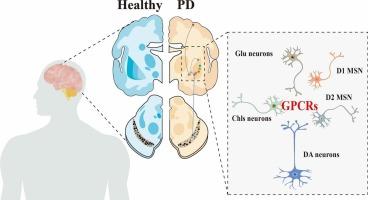G蛋白偶联受体:维持帕金森病基底神经节-丘脑-皮质回路功能的关键靶点
IF 5.6
2区 医学
Q1 PHARMACOLOGY & PHARMACY
引用次数: 0
摘要
帕金森病(PD)是仅次于阿尔茨海默病的第二大常见神经退行性疾病,临床表现为静息性震颤、僵硬和姿势平衡障碍。其病理实质是黑质致密部(SNpc)多巴胺能神经元进行性退行性死亡,导致纹状体多巴胺(DA)水平显著降低。这导致基底神经节-丘脑-皮质(BGTC)回路功能障碍。该回路是运动控制的核心神经回路,其异常不仅直接导致PD的运动症状,而且通过神经递质信号紊乱参与疾病进展的级联反应。目前,DA替代疗法和DA受体激动剂仍是临床治疗的主要方法,但单一疗法不能完全纠正其他神经递质系统失衡,在长期疗效和症状管理方面存在明显局限性。G蛋白偶联受体(gpcr)作为最大的膜蛋白家族,由于其广泛参与生理调控网络和良好的药物开发潜力,已成为PD治疗的重要靶点。这些跨膜信号分子通过精确调节神经递质的释放、维持突触可塑性和神经回路的动态平衡,在PD病理过程的多个关键节点中发挥重要作用。在此,我们回顾了BCTG在PD中的转变,并重点介绍了gpcr在该循环中介导PD的病理级联。最后,我们更新了正在研究的用于治疗PD的GPCR药物的临床试验或批准。本文章由计算机程序翻译,如有差异,请以英文原文为准。

G Protein-coupled receptors: key targets for maintaining the function of basal ganglia-thalamus-cortical circuits in Parkinson’s disease
Parkinson’s Disease (PD), the second most common neurodegenerative disease after Alzheimer’s disease, is clinically characterized by resting tremor, rigidity and postural balance disorder. Its pathological essence is the progressive degenerative death of dopaminergic neurons in the substantia nigra pars compacta (SNpc), leading to a significant decrease in striatal dopamine (DA) levels. This results in the dysfunction of basal ganglia-thalamus-cortex (BGTC) circuit. This circuit is the core neural circuit of motor control, and its abnormality not only directly causes the motor symptoms of PD, but also participates in the cascade of disease progression through the disorder of neurotransmitter signals. At present, DA replacement therapy and DA receptors (DARs) agonists are still the main methods of clinical treatment, but single therapy cannot fully correct the imbalance of other neurotransmitter systems, which has significant limitations in long-term efficacy and symptom management. G protein-coupled receptors (GPCRs), as the largest family of membrane proteins, have become important targets for PD treatment due to their extensive participation in physiological regulatory networks and excellent drug development potential. These transmembrane signaling molecules play important roles in multiple key nodes in the pathological process of PD by precisely regulating the release of neurotransmitters, the maintenance of synaptic plasticity and the dynamic balance of neural circuits. Here, we review the transition of BGTC in the context of PD and then focus on the pathological cascade of GPCRs mediating PD in this loop. Finally, we update the clinical trials or approvals of GPCR drugs under investigation for the treatment of PD.
求助全文
通过发布文献求助,成功后即可免费获取论文全文。
去求助
来源期刊

Biochemical pharmacology
医学-药学
CiteScore
10.30
自引率
1.70%
发文量
420
审稿时长
17 days
期刊介绍:
Biochemical Pharmacology publishes original research findings, Commentaries and review articles related to the elucidation of cellular and tissue function(s) at the biochemical and molecular levels, the modification of cellular phenotype(s) by genetic, transcriptional/translational or drug/compound-induced modifications, as well as the pharmacodynamics and pharmacokinetics of xenobiotics and drugs, the latter including both small molecules and biologics.
The journal''s target audience includes scientists engaged in the identification and study of the mechanisms of action of xenobiotics, biologics and drugs and in the drug discovery and development process.
All areas of cellular biology and cellular, tissue/organ and whole animal pharmacology fall within the scope of the journal. Drug classes covered include anti-infectives, anti-inflammatory agents, chemotherapeutics, cardiovascular, endocrinological, immunological, metabolic, neurological and psychiatric drugs, as well as research on drug metabolism and kinetics. While medicinal chemistry is a topic of complimentary interest, manuscripts in this area must contain sufficient biological data to characterize pharmacologically the compounds reported. Submissions describing work focused predominately on chemical synthesis and molecular modeling will not be considered for review.
While particular emphasis is placed on reporting the results of molecular and biochemical studies, research involving the use of tissue and animal models of human pathophysiology and toxicology is of interest to the extent that it helps define drug mechanisms of action, safety and efficacy.
 求助内容:
求助内容: 应助结果提醒方式:
应助结果提醒方式:


